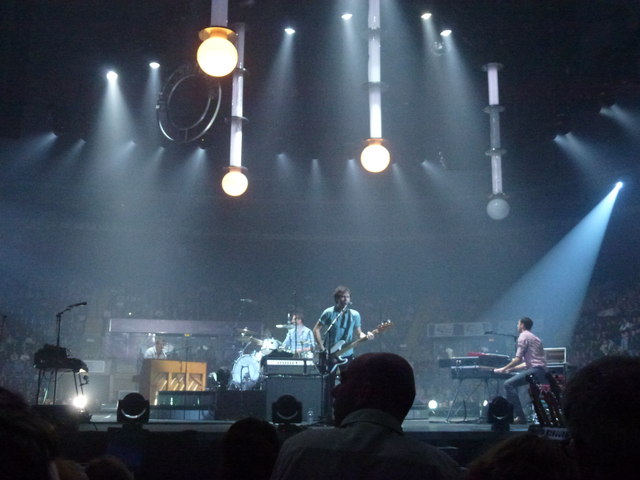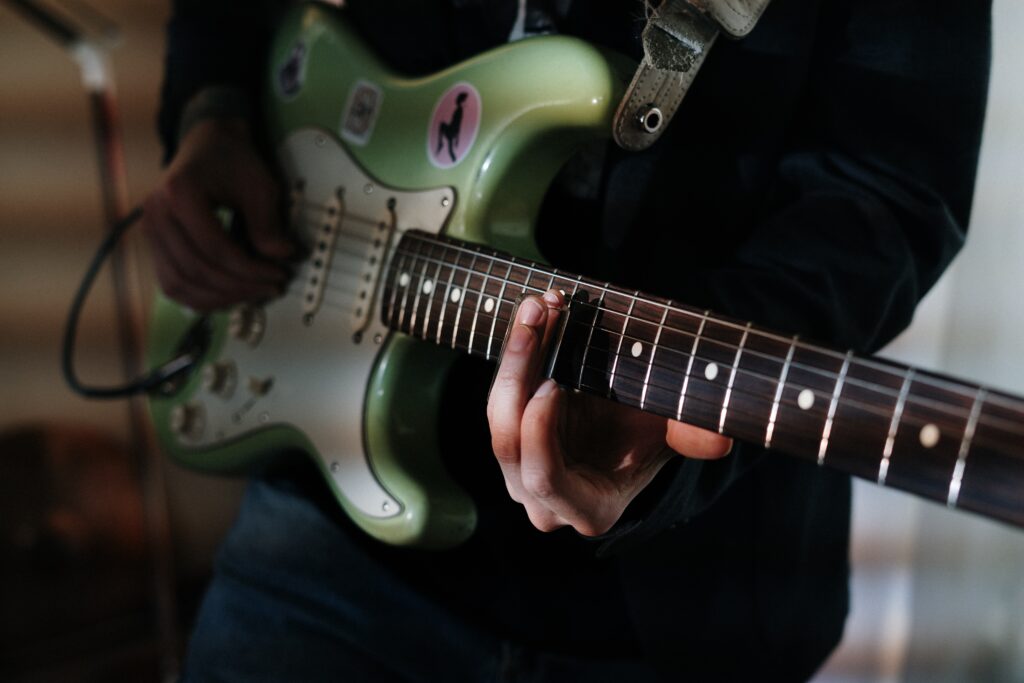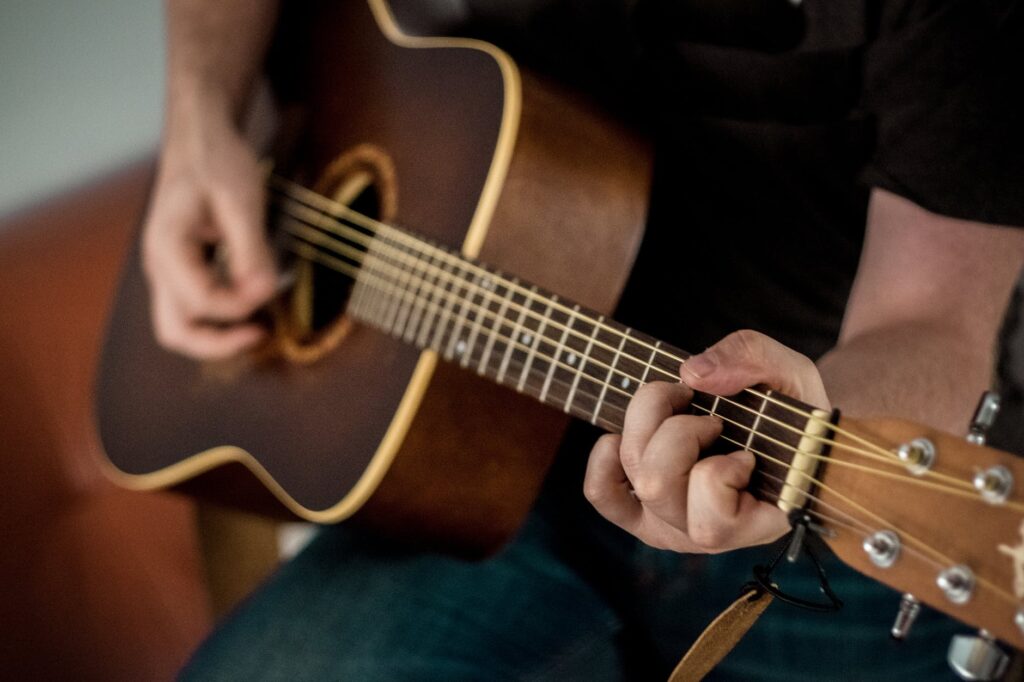
From the moment you hear the melodic rhythm of percussive guitar, you can’t help but be captivated by its unique blend of musicality and percussion. This dynamic technique takes the art of playing acoustic guitar to a whole new level, infusing beats and rhythms right into the strings. In this article, we’ll dive deep into the world of percussive acoustic guitar, exploring the techniques, styles, and creative possibilities that come with it.
Table of Contents
- Introduction
- Understanding Percussive Acoustic Guitar
- 2.1 The Essence of Percussive Fingerstyle
- 2.2 The Birth of Slap Guitar
- Techniques for Percussive Playing
- 3.1 Body Percussion: Your Guitar as a Drum
- 3.2 Slap Techniques: Striking a Balance
- Mastering Percussive Fingerstyle
- 4.1 Developing Finger Independence
- 4.2 Combining Melodies and Beats
- The Allure of Slap Guitar
- 5.1 Creating Grooves with Slap Bass Notes
- 5.2 Tapping into Percussive Harmonics
- Expanding Your Repertoire: Percussive Cover Songs
- 6.1 Reimagining Classics with Percussive Elements
- 6.2 Adding a Unique Flavor to Modern Hits
- Crafting Your Own Percussive Style
- 7.1 Finding Your Rhythmical Signature
- 7.2 Experimenting with Unconventional Techniques
- Gear and Equipment for Percussive Guitarists
- 8.1 Choosing the Right Acoustic Guitar
- 8.2 Exploring Essential Accessories
- Recording and Live Performance Tips
- 9.1 Capturing Percussive Sounds in the Studio
- 9.2 Engaging Audiences with Live Percussive Performances
- Overcoming Challenges in Percussive Playing
- 10.1 Building Finger Strength and Endurance
- 10.2 Achieving Consistent Timing and Precision
- Inspiring Artists in the Percussive Genre
- 11.1 Andy McKee: Pioneering Percussive Fingerstyle
- 11.2 Newton Faulkner: Redefining Acoustic Performance
- The Future of Percussive Guitar
- 12.1 Pushing Boundaries with Technology
- 12.2 Incorporating Percussion in Collaborations
- Conclusion
Introduction
Percussive guitar, an innovative fusion of rhythm and melody, has taken the music world by storm. It’s a genre-defying approach that turns the guitar into a versatile instrument capable of producing beats, tones, and harmonies that evoke a symphony of emotions. In this article, we’ll peel back the layers of percussive acoustic guitar, revealing its techniques, evolution, and the trailblazing artists who have carved their names into its rhythmic history.
Understanding Percussive Acoustic Guitar
The Essence of Percussive Fingerstyle
At its core, percussive fingerstyle is about coaxing rhythm from the strings through a combination of fingerpicking and percussive techniques. By incorporating slaps, taps, and knocks, players turn their guitar into a percussion ensemble, creating a captivating sonic experience that goes beyond traditional guitar playing. The result is a symphony of sound that dances between melody and rhythm, keeping listeners enthralled.
The Birth of Slap Guitar
Slap guitar, a subcategory of percussive playing, adds a rhythmic dimension by incorporating slaps and taps on the guitar’s body and strings. Originating from various folk and flamenco styles, slap guitar found its spotlight with artists like Michael Hedges and Preston Reed, who pushed the boundaries of acoustic guitar playing in the 1980s. The technique gained popularity as musicians embraced its potential to emulate drums and percussions.
Techniques for Percussive Playing
Body Percussion: Your Guitar as a Drum
Body percussion is a cornerstone of percussive guitar. By tapping, thumping, and knocking on different parts of the guitar’s body, players create a range of percussive sounds that add depth and rhythm to their compositions. The guitar becomes not just an instrument but a canvas for artistic expression, where every touch produces a unique sound.
Slap Techniques: Striking a Balance
Slap techniques involve striking the strings with your thumb or fingers to produce sharp percussive sounds. The challenge lies in maintaining a balance between slaps and melodic notes, creating a seamless integration of rhythm and melody. Aspiring slap guitarists must master finger control and precision to achieve a harmonious blend of beats and tones.
Mastering Percussive Fingerstyle
Developing Finger Independence
Percussive fingerstyle demands finger independence like no other technique. Each finger becomes a percussionist, contributing to the intricate rhythmic tapestry. Through diligent practice and finger exercises, players enhance their finger control, allowing them to effortlessly weave together melodies and percussive elements.
Combining Melodies and Beats
The magic of percussive fingerstyle lies in the seamless fusion of melody and rhythm. Players often create a melody on the higher strings while using the lower strings for percussive effects. This interplay generates a mesmerizing auditory experience that showcases the guitar’s potential to be a one-person band.
The Allure of Slap Guitar
Creating Grooves with Slap Bass Notes
Slap guitarists conjure rich bass-like sounds by slapping the lower strings with their thumb. These bass notes inject depth and groove into compositions, mimicking the presence of a bass guitar. The combination of bass slaps, melodic plucking, and percussive beats paints a vivid sonic landscape that captivates audiences.
Tapping into Percussive Harmonics
Harmonics, those ethereal chimes produced by lightly touching the strings, find a unique place in percussive guitar. By integrating harmonic taps into their playing, guitarists add an otherworldly dimension to their compositions. These harmonics act as fleeting notes, embellishing the rhythm with a touch of enchantment.
Expanding Your Repertoire: Percussive Cover Songs
Reimagining Classics with Percussive Elements
One of the most delightful aspects of percussive guitar is its ability to breathe new life into classic songs. By infusing beloved melodies with percussive techniques, musicians create renditions that honor the original while offering a fresh perspective. The marriage of nostalgia and innovation results in cover versions that resonate deeply with listeners.
Adding a Unique Flavor to Modern Hits
Percussive guitarists also reimagine contemporary hits, transforming them into acoustic masterpieces that dazzle with rhythm and creativity. With the flick of a finger, a tap of the thumb, and the resonance of strings, they turn pop, rock, and even electronic tracks into soulful renditions that reveal the hidden potential of familiar tunes.
Crafting Your Own Percussive Style
Finding Your Rhythmical Signature
In the world of percussive guitar, individuality shines bright. Every player has the opportunity to craft their own rhythmical signature by combining various techniques, rhythms, and melodies. This journey of self-discovery leads to a unique playing style that resonates with the artist’s personality, inviting listeners into a sonic world they’ve never experienced before.
Experimenting with Unconventional Techniques
Percussive guitarists are explorers of sound, constantly pushing the boundaries of what’s possible. By incorporating unconventional techniques like body slaps, percussive tapping, and string muting, they create a symphony of textures that defy traditional norms. The guitar becomes a playground for innovation, fostering an environment where creativity knows no limits.
Gear and Equipment for Percussive Guitarists
Choosing the Right Acoustic Guitar
The choice of acoustic guitar significantly influences the percussive experience. Guitars with a balanced tonal range, responsive top woods, and sturdy construction excel in capturing the nuances of percussive playing. Many players opt for guitars with cutaways to facilitate access to higher frets, enabling them to explore the entire sonic spectrum.
Exploring Essential Accessories
Accessories such as fingerpicks, thumb rings, and percussion implements open up new avenues of sonic exploration. Fingerpicks allow players to emphasize percussive elements, while thumb rings aid in generating resonant bass notes. Percussion implements like small shakers and beaters expand the sonic palette, enabling guitarists to experiment with diverse rhythmic textures.
Recording and Live Performance Tips

Capturing Percussive Sounds in the Studio
Recording percussive guitar involves capturing the intricate interplay of melody and rhythm. Close-miking techniques ensure that the percussive nuances are faithfully reproduced. Additionally, experimenting with microphone placements and room acoustics can yield unique sonic qualities that elevate the final recording.
Engaging Audiences with Live Percussive Performances
Live percussive performances are a visual and auditory spectacle. Guitarists showcase their rhythmic prowess through animated body movements, intricate fingerwork, and percussive flourishes. Engaging with the audience through eye contact and enthusiastic stage presence adds an immersive layer to the performance, leaving a lasting impact.
Overcoming Challenges in Percussive Playing
Building Finger Strength and Endurance
Percussive playing demands finger strength and endurance. Regular finger exercises, stretches, and controlled practice sessions help build the required finger muscles over time. Gradually increasing the complexity of percussive patterns challenges the fingers while fostering growth and adaptability.
Achieving Consistent Timing and Precision
The hallmark of a skilled percussive guitarist is precise timing. Practicing with a metronome and focusing on rhythm exercises helps in cultivating a strong sense of timing. By internalizing rhythmic patterns, players ensure that every slap, tap, and melody is executed with impeccable precision.
Inspiring Artists in the Percussive Genre
Andy McKee: Pioneering Percussive Fingerstyle
Andy McKee’s groundbreaking approach to percussive fingerstyle has earned him global recognition. His composition “Drifting” showcases a blend of complex tapping, harmonics, and rhythmic slaps that have inspired a generation of guitarists. McKee’s ability to create lush soundscapes solely with his guitar exemplifies the boundless potential of percussive playing.
Newton Faulkner: Redefining Acoustic Performance
Newton Faulkner’s percussive prowess has breathed new life into the acoustic genre. His rhythmic style, characterized by inventive tapping, body percussion, and unique tuning, has set him apart as a trailblazer in the percussive guitar movement. Faulkner’s music resonates with audiences not just for its technical virtuosity, but for its emotional depth.
The Future of Percussive Guitar
Pushing Boundaries with Technology
The future of percussive guitar is intertwined with technology. Innovations in amplification, effects pedals, and electronic enhancements are expanding the creative horizons of percussive players. These advancements enable guitarists to layer their soundscapes, experiment with digital beats, and create immersive sonic experiences.
Incorporating Percussion in Collaborations
Percussive guitarists are finding exciting collaborations with percussionists, vocalists, and other instrumentalists. These collaborations enrich the sonic tapestry by integrating diverse elements into percussive compositions. The fusion of different musical worlds results in transcendent performances that bridge genres and captivate listeners.
Conclusion
Percussive guitar is a testament to the boundless creativity of musicians. It’s a journey that combines rhythm, melody, and innovation to craft a musical experience that defies conventions. As you embark on your own percussive journey, remember that the guitar is not just an instrument—it’s a canvas where you paint intricate rhythms, evoke emotions, and leave an indelible mark on the world of music.
Frequently Asked Questions
- Can I learn percussive guitar techniques if I’m a beginner guitarist?Absolutely! While some techniques may require time and practice to master, beginners can start by learning basic fingerpicking and incorporating simple percussion elements. As your skills develop, you can gradually explore more advanced techniques.
- What type of guitar strings are best for percussive playing?Light to medium gauge strings are often preferred for percussive playing, as they offer a good balance between playability and tone. However, the choice of strings can also depend on personal preference and the specific sound you’re aiming to achieve.
- Are there online resources available for learning percussive guitar?Yes, there are numerous online tutorials, courses, and videos dedicated to teaching percussive guitar techniques. These resources cover everything from basic fingerstyle to advanced percussive elements, making it accessible to learners of all levels.
- Is finger strength more important than speed in percussive playing?Both finger strength and speed are crucial in percussive playing. Building finger strength allows you to execute techniques with control and precision, while speed enables you to create intricate rhythmic patterns and seamless transitions between techniques.
- Can I incorporate percussive elements into my original compositions?Absolutely! In fact, integrating percussive techniques into your original compositions can add a unique flavor and depth to your music. Experiment with different techniques and rhythms to create compositions that reflect your personal style and creativity.

